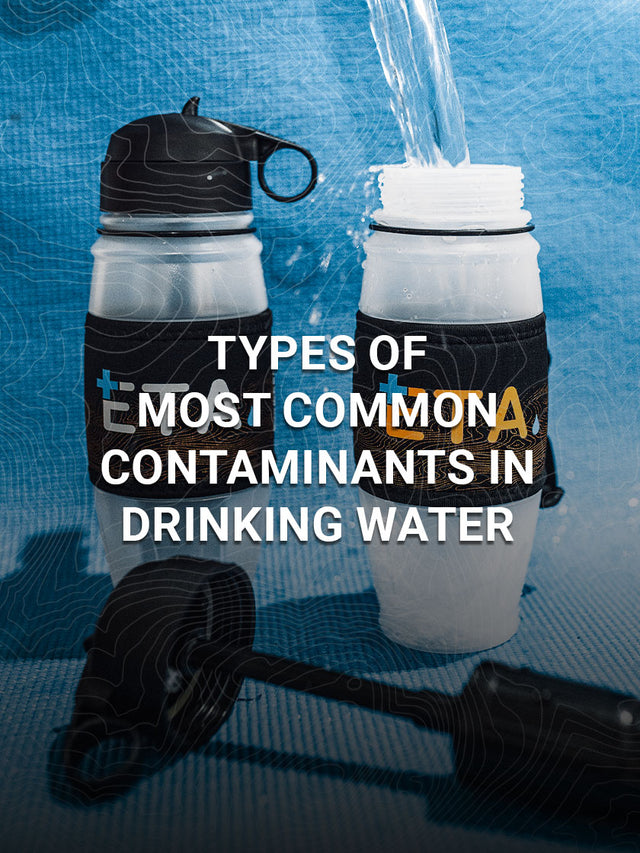
Types of Most Common Contaminants in Drinking Water
Being able to taste, smell, or see a pollutant is already bad enough. But what if your water seems to taste, smell, and appear fine?
It's been stated that the best medication in the world is clean water. One of the most important aspects of preserving health and avoiding infections is staying hydrated. In order to accomplish this, one requires access to abundant, safe, and clean water; to survive and to live a healthy, long life. However, this can be difficult, especially if you reside in an area where the drinking water sources are contaminated or impure. Only clean water can keep us safe and hydrated. With unclean water you will be subjected to many different types of diseases and infections hazardous for your health and in certain cases, they may even cause death. Due to this, people are likely to limit the amount of water consumption leading to other conditions such as inadequate hydration to chronic dehydration and beyond. Either way, contaminated water and its effect on health is a vicious loop which can only be broken by clean and purified drinking water.
This is why it is crucial to pay close attention to the most common contaminants in drinking water in the United States and identify what you can do to cleanse out your water.

Contaminated drinking water
By their very nature, all water sources contain some level of contamination, both natural and man-made. Water comes into contact with a variety of substances as it flows through our streams, lakes, rivers, and oceans and filters through different rock formations and soil, all of which will absorb into the water source.
Furthermore, a fresh batch of chemicals and additives are added as water is processed at various facilities by municipalities to prepare it for delivery to residents.
Our local streams, rivers, beaches, and groundwater aquifers are affected by trash, bacteria, pet waste, dirt in old septic tanks, fecal bacteria, litter, pesticides and herbicides, dust from car brake pads, and many other pollutants. This is why it is necessary to keep a watchful eye to avoid contaminated drinking water.
Most Common Contaminants in Drinking Water
Organic and microbial pollutants are sometimes difficult for humans to detect. Years may pass before a problem is detected and further investigation and solution may take even longer. Many people don't start to show suspicion until members of the neighborhood start to fall ill. Hazardous organic material from pesticide or fertilizer application may be present in water close to agricultural regions. Pesticides and fertilizer chemicals in water can harm the eyes, liver, kidneys, and other organs as well as increasing the risk of cancer and reproductive issues. Exposed people who live close to industrial plants may experience similar issues.

We have listed out the most commonly occurring contaminants in the drinking water system that you must be aware of.
- Nitrates
Nitrates are a class of compounds that are frequently present in fertilizers, manures, and liquid waste from septic tanks and plumbing systems. They are one of the most prevalent types of water contaminants, especially in rural areas. It can easily form with our groundwater supplies and transform into nitrate when nitrogen in fertilizer is either left behind by plants or taken off by runoff.
- Arsenic
Arsenic is a metallic chemical that occurs naturally in trace levels in organic form. There are two ways arsenic might get into your drinking water. A very small number of areas, including Illinois, have mineral formations that may contain traces of arsenic. More frequently, arsenic can enter your water from hazardous waste that is created by enterprises that manufacture arsenic.
- Bacteria, viruses, and microbes
Everybody's water has some bacteria and protozoans. While the majority of these tiny critters are safe, some, like Legionella pneumophila and E. Coli, can be highly harmful. In reality, these microbes and illnesses have the potential to harm greatly, and in some cases even result in death, especially in infants and the elderly. It can also result in severe loss of immunity and dire impacts on health in adults.
- Aluminum
Since aluminum is the third most prevalent element in the soil, water, and air of the Earth, it may quickly enter our water systems. Aluminum contamination in our tap water has received particular attention recently, and towns with high amounts of aluminum in their drinking water have been linked to dementia. Anemia, kidney disorders, and harm to the brain system are further health impacts of aluminum.
- Fluoride
Fluoride is a naturally occurring mineral found in the soil of the Earth and has long been recommended as a beneficial water additive to help prevent tooth decay. Fluoride-containing substances have been incorporated into our water supplies since the 1940s. However, current data suggest that fluoride can be more harmful than beneficial. Fluorosis, a change in dental enamel that can result in white patches and stains, can be brought on by excessive fluoride levels. High quantities of fluoride can concentrate in the bone, weakening the skeletal system ineluctably.
The Revolutionary ETA Alkaline Water Filter Bottle
Since there wasn't a water purifier that could be trusted to generate Extreme Filtration, particularly in a crisis or emergency, ETA was developed as a breakthrough. The ETA Alkaline Water Filter Bottle uses the most recent Ionic Adsorption Micro Filtration (IAMF) Technology, which starts the filtration process with a straightforward but distinctive "Sip and Squeeze" mechanism. Because of its ease of use, it is a great addition to your water purification routine for daily consumption purposes.

Besides the convenience of usage, chemical, dissolved solids, aesthetic, and radioactive elements are all removed from any water source (except saltwater) using ETA's Extreme Filtration capability, and simultaneously, alkaline water with a pH of 9.5 that lasts up to 30 days is produced.
One of the most worrying and essential components when battling the list of water-borne diseases as well as contaminants, safe, clean, and contamination-free water is guaranteed to be made easier with ETA's specific competence in Extreme Filtration.
A simple method to ensure proper hydration is to keep your ETA Alkaline Water Filter Bottle close at hand. By simply purifying your undrinkable water and making it safe to consume, ETA can assist you in avoiding the most common symptoms and illnesses, whether you are traveling with limited access to trustable water sources or if you are unsure of the quality of your water source that you use to fulfill your daily hydration needs.
